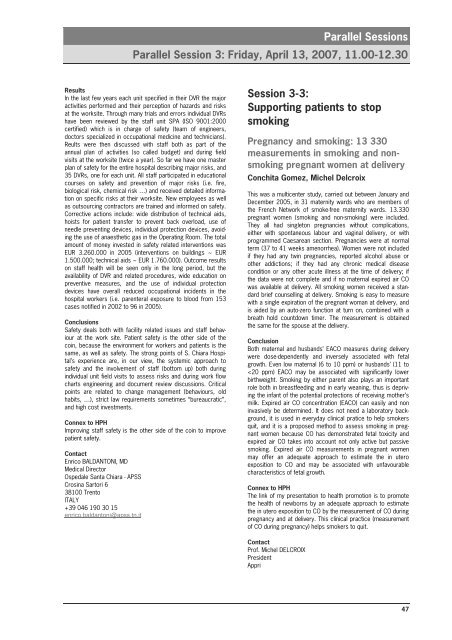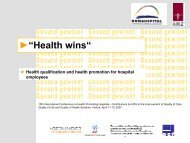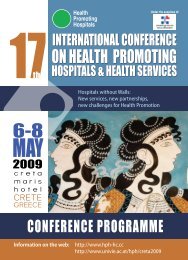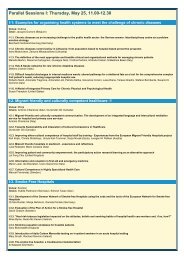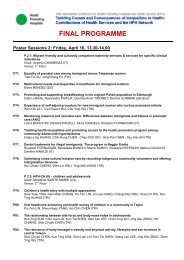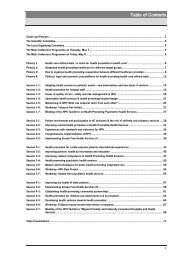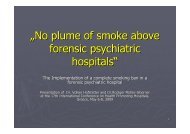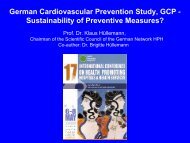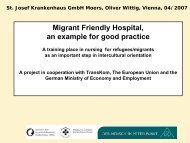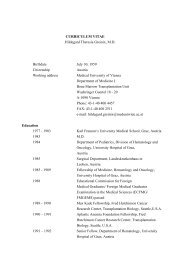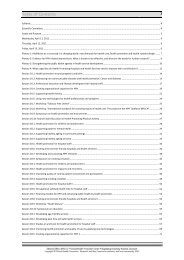Plenary 1: The Hospital – A Staff Empowering ... - HPH-Conference
Plenary 1: The Hospital – A Staff Empowering ... - HPH-Conference
Plenary 1: The Hospital – A Staff Empowering ... - HPH-Conference
You also want an ePaper? Increase the reach of your titles
YUMPU automatically turns print PDFs into web optimized ePapers that Google loves.
Parallel Sessions<br />
Parallel Session 3: Friday, April 13, 2007, 11.00-12.30<br />
Results<br />
In the last few years each unit specified in their DVR the major<br />
activities performed and their perception of hazards and risks<br />
at the worksite. Through many trials and errors individual DVRs<br />
have been reviewed by the staff unit SPA (ISO 9001:2000<br />
certified) which is in charge of safety (team of engineers,<br />
doctors specialized in occupational medicine and technicians).<br />
Reults were then discussed with staff both as part of the<br />
annual plan of activities (so called budget) and during field<br />
visits at the worksite (twice a year). So far we have one master<br />
plan of safety for the entire hospital describing major risks, and<br />
35 DVRs, one for each unit. All staff participated in educational<br />
courses on safety and prevention of major risks (i.e. fire,<br />
biological risk, chemical risk …) and received detailed information<br />
on specific risks at their worksite. New employees as well<br />
as outsourcing contractors are trained and informed on safety.<br />
Corrective actions include: wide distribution of technical aids,<br />
hoists for patient transfer to prevent back overload, use of<br />
needle preventing devices, individual protection devices, avoiding<br />
the use of anaesthetic gas in the Operating Room. <strong>The</strong> total<br />
amount of money invested in safety related interventions was<br />
EUR 3.260.000 in 2005 (interventions on buildings ~ EUR<br />
1.500.000; technical aids ~ EUR 1.760.000). Outcome results<br />
on staff health will be seen only in the long period, but the<br />
availability of DVR and related procedures, wide education on<br />
preventive measures, and the use of individual protection<br />
devices have overall reduced occupational incidents in the<br />
hospital workers (i.e. parenteral exposure to blood from 153<br />
cases notified in 2002 to 96 in 2005).<br />
Conclusions<br />
Safety deals both with facility related issues and staff behaviour<br />
at the work site. Patient safety is the other side of the<br />
coin, because the environment for workers and patients is the<br />
same, as well as safety. <strong>The</strong> strong points of S. Chiara <strong>Hospital</strong>’s<br />
experience are, in our view, the systemic approach to<br />
safety and the involvement of staff (bottom up) both during<br />
individual unit field visits to assess risks and during work flow<br />
charts engineering and document review discussions. Critical<br />
points are related to change management (behaviours, old<br />
habits, …), strict law requirements sometimes “bureaucratic”,<br />
and high cost investments.<br />
Connex to <strong>HPH</strong><br />
Improving staff safety is the other side of the coin to improve<br />
patient safety.<br />
Contact<br />
Enrico BALDANTONI, MD<br />
Medical Director<br />
Ospedale Santa Chiara - APSS<br />
Crosina Sartori 6<br />
38100 Trento<br />
ITALY<br />
+39 046 190 30 15<br />
enrico.baldantoni@apss.tn.it<br />
Session 3-3:<br />
Supporting patients to stop<br />
smoking<br />
Pregnancy and smoking: 13 330<br />
measurements in smoking and nonsmoking<br />
pregnant women at delivery<br />
Conchita Gomez, Michel Delcroix<br />
This was a multicenter study, carried out between January and<br />
December 2005, in 31 maternity wards who are members of<br />
the French Network of smoke-free maternity wards. 13.330<br />
pregnant women (smoking and non-smoking) were included.<br />
<strong>The</strong>y all had singleton pregnancies without complications,<br />
either with spontaneous labour and vaginal delivery, or with<br />
programmed Caesarean section. Pregnancies were at normal<br />
term (37 to 41 weeks amenorrhea). Women were not included<br />
if they had any twin pregnancies, reported alcohol abuse or<br />
other addictions; if they had any chronic medical disease<br />
condition or any other acute illness at the time of delivery; if<br />
the data were not complete and if no maternal expired air CO<br />
was available at delivery. All smoking women received a standard<br />
brief counselling at delivery. Smoking is easy to measure<br />
with a single expiration of the pregnant woman at delivery, and<br />
is aided by an auto-zero function at turn on, combined with a<br />
breath hold countdown timer. <strong>The</strong> measurement is obtained<br />
the same for the spouse at the delivery.<br />
Conclusion<br />
Both maternal and husbands’ EACO measures during delivery<br />
were dose-dependently and inversely associated with fetal<br />
growth. Even low maternal (6 to 10 ppm) or husbands’ (11 to<br />


